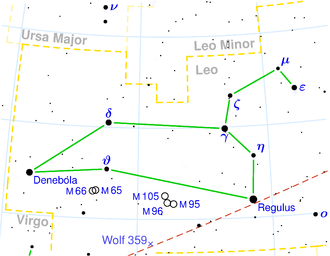NGC 3357
| Galaxy NGC 3357 |
|
|---|---|
![NGC 3357 with LEDA 3090728 [1] (ro)](https://upload.wikimedia.org/wikipedia/commons/thumb/b/b1/NGC3357_-_SDSS_DR14.jpg/300px-NGC3357_-_SDSS_DR14.jpg)
|
|
| NGC 3357 with LEDA 3090728 (ro) | |
| AladinLite | |
| Constellation | lion |
|
Position equinox : J2000.0 , epoch : J2000.0 |
|
| Right ascension | 10 h 44 m 20.7 s |
| declination | + 14 ° 05 ′ 04 ″ |
| Appearance | |
| Morphological type | E +: |
| Brightness (visual) | 13.0 likes |
| Brightness (B-band) | 14.0 mag |
| Angular expansion | 1.3 ′ × 1.2 ′ |
| Position angle | 90 ° |
| Surface brightness | 13.6 mag / arcmin² |
| Physical data | |
| Redshift | 0.032719 ± 0.000167 |
| Radial velocity | 9809 ± 50 km / s |
|
Stroke distance v rad / H 0 |
(434 ± 30) · 10 6 ly (133.1 ± 9.3) Mpc |
| history | |
| discovery | Albert Marth |
| Discovery date | April 5, 1864 |
| Catalog names | |
| NGC 3357 • UGC 5206 • 5854A • PGC 32032 • CGCG 066-006 • MCG + 02-28-002 • 2MASX J10442076 + 1405043 • GALEX ASC J104420.66 + 140502.9 • LDCE 748 NED002 | |
NGC 3357 is an elliptical galaxy with an active nucleus of the Hubble type E1 in the constellation Leo on the ecliptic . It is an estimated 434 million light years from the Milky Way and about 170,000 light years across.
In the same area of the sky is u. a. the galaxy NGC 3338 , NGC 3346 , NGC 3367 , NGC 3377 .
The object was discovered by Albert Marth on April 5, 1864 .
